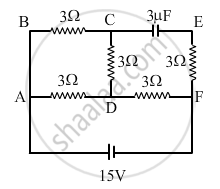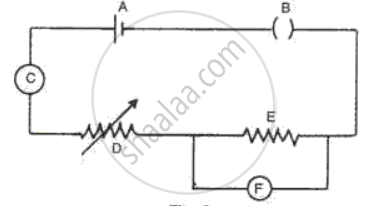Advertisements
Advertisements
प्रश्न
In the circuit shown in the figure, find the total resistance of the circuit and the current in the arm AD.

उत्तर
Since the capacitor will act as an open circuit here, the arm CE and EF will become ineffective. The circuit is now reduced to as below

Effective resistance across AD = (BC + CD) ∥ AD
= \[\left( 3 + 3 \right) \lVert 3 = 2 \Omega\]
Total resistance of the circuit = AD + DF = 2 + 3 = 5 Ω
Total current in the circuit = \[\frac{15}{5} = 3 A\]
The current through AD and BCD will divide in the inverse ratio of the resistance.
∴ Current through AD = \[3 \times \frac{6}{\left( 6 + 3 \right)} = 3 \times \frac{6}{9} = 2 A\]
APPEARS IN
संबंधित प्रश्न
Find the resistance of a conductor if 0.24 A current is passing through it and a potential difference of 24 V is applied across it.
What is an Ohmic resistor?
The graph between V and I for a conductor is a straight line passing through the origin.
Which law is illustrated by such a graph?
How much energy is consumed when a current of 5 amperes flows through the filament (or element) of a heater having resistance of 100 ohms for two hours? Express it in joules.
In a conductor 6.25 × `10^16` electrons flow from its end A to B in 2 s. Find the current flowing through the conductor (e = 1.6 × `10^-19` C)
Fig. represents the circuit used for the verification of Ohm's law. Label the parts from A to F. state the function of each.

Answer the following question.
Distinguish between Ohmic and non-ohmic substances; explain with the help of example.
The heat produced by a 100 w heater in 2 minute is equal to
The resistance of a resistor is reduced to half of its initial value. If other parameters of the electrical circuit remain unaltered, the amount of heat produced in the resistor will become ______.
The voltage - current readings of a certain material are shown in the table given below:
| Voltage (V) | 10 V | 20 V | 30 V |
| Current (I) | 2 A | 3 A | 4 A |
Study the table.
- State whether the conductor used is ohmic or non-ohmic.
- Justify your answer.
- State Ohm's law.
